The 7,210grt Kingsbury was built in Bethlehem-Fairfield Shipyard at Baltimore as the Liberty Ship Samlamu. She became Kingsbury in 1947. In 1960 she was sold to the Polish SS Co. and renamed Huta Bedzin and in 1969 she was hulked and renamed MP-ZP-GDY-6. She was broken up by Haminan Laivaromu Oy at Hamina during July 1982. (FotoFlite)
Capper, Alexander & Co
Capper, Alexander & Company was registered in 1875 at 5, Mount Stuart Square, Cardiff by Edward H. Capper and Edward Alexander to own two iron full-rigged clipper ships, Aberaman and Abercarne, then building at Stockton by Richardson. The Capper family hailed from London, Capt. E.H. Capper having been in command of sailing ships since 1864 at the age of 25 years, and he came ashore around 1872 to establish his shipbroking business in Cardiff. Edward Alexander had previously been engaged in shipbuilding at Hartlepool, rising to become head cashier for Denton, Gray & Company before forming a partnership in 1869 with Edward Withy as Withy, Alexander & Company to take over the Middleton shipyard of Denton, Gray & Company. Edward Alexander withdrew in late 1873 from his shipyard, which had built thirty steamers in that five year period, and moved to Cardiff to join his cousin Capt. E.H. Capper.
Edward H. Capper purchased three steamers during 1876/77 and registered them under his own name. Around 1880 he moved back to London to open an office at 14,St. Mary Axe, almost next door to the Baltic Exchange where charters for the ships were fixed. He was sadly diagnosed as suffering from a serious heart condition and was sent by his doctor on a long voyage, and died at Newcastle (NSW) soon after landing. The three steamers under his own name were transferred to Capper, Alexander & Company during 1883. Five more steamers had also joined the company including the Sunderland built City of Durham and the Stockton built George Fisher. However the shipping slump of the mid-1880s meant that by 1886 only the latter was owned. She too, found a buyer in Cardiff, F. Binnington, but the sale did not complete and the ship reverted to Capper, Alexander & Company. She was then the only owned ship for nearly twenty years with Edward Alexander closing the Cardiff office in 1886 and moving to London. The elderly clipper-bowed steam tramp Isle of Hastings was purchased in 1907 from Dixon, Robson & Company. The ubiquitous George Fisher continued to give good service to the company until the end of WWI when she was sold to Hull owners and finally wrecked in September 1920.
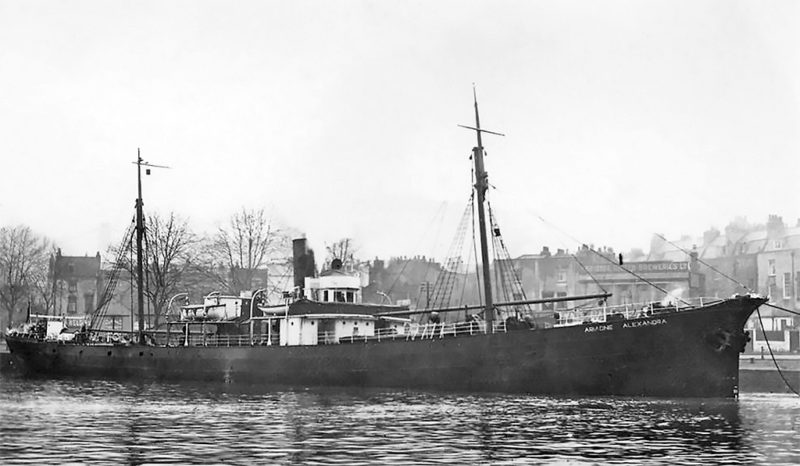
The acquisition of further second-hand tramps was accelerated between 1910 and 1914 with four additions, the last of which was the Clyde built Gogovale of 1904. She was renamed Westbury and registered under the Alexander Shipping Co. Ltd., formed during 1914 by Edward Alexander, to expand the fleet with ‘Bury’ names on his coal out to the River Plate trade followed by charter to Houlder Brothers for the return on their liner service or with grain. Six tramps were owned on the outbreak of war on 5th August 1914 and four of these were to be lost as well as the purchased Obi, renamed Ledbury in 1916:-
30.11.1915 Middleton
Captured/sunk by gunfire by U-39 75 miles WSW of Gavdo Island, Crete on a voyage from Mudros to Alexandria with sandbags, 4 lost.
5.10.1916 Isle of Hastings
Captured/sunk by bombs 10 miles SW of Ushant by UC-26 on a voyage from Fray Bentos to London with tinned meat.
26.3.1917 Ledbury
Shelled/sunk by UB-43 90 miles NE of Benghazi on a voyage from Karachi to Italy with maize, barley and peas, 3 lost.
31.8.1917 Westbury
Torpedoed/sunk by U-48 8 miles SSE of Fastnet on a voyage from Barry to Halifax (NS) with coal.
11.10.1918 Lorle
Torpedoed/sunk by UB-103 12 miles SSW of The Lizard on a voyage from Bilbao to Heysham with iron ore, 19 lost including Master.
The Turnbull tramp Alton was purchased in 1917 but not renamed as Aylesbury until 1919, and she was joined before the war had ended by the Pyman tramp Southwaite renamed Sudbury, and the Cardiff tramp Ilwen renamed Kingsbury.
The clipper-bowed Ariadne Alexandra, purchased in 1910 from G. Sechiari under the Red Duster, had survived the war and traded initially in the post-war boom alongside three ‘Bury’ ships, with ten further second-hand tramps acquired between 1919 and 1926. These included:-
- Pyman’s former tramp Coniston renamed Shrewsbury.
- Chellew’s Penpol renamed Malmesbury.
- Burrell’s former Strathan renamed Queensbury.
- J.& C. Harrison’s former Harmonic renamed Eastbury.
- Five German prizes sold at auction and renamed Thornbury, Charlbury, Tenbury, Ledbury and Westbury.
The latter ship was also probably managed by Capper, Alexander on behalf of the Shipping Controller from 1919 to 1921 as the German Montevideo after being taken in prize from the Hamburg-South America Line.
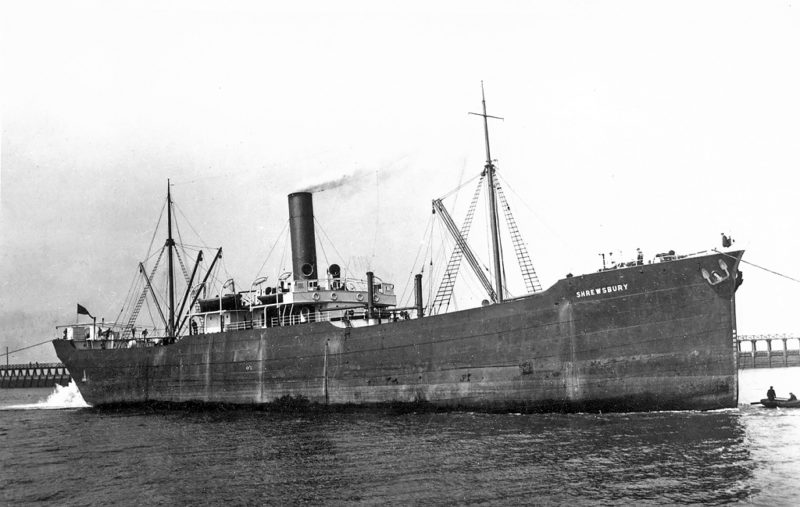

The ex-German prize Westbury was wrecked 12 miles West of Necochea in Argentina on 1st April 1924. Edward Alexander died in 1925 and the family business was continued by his three sons Charles, Frank S., and Waldemar J. Alexander with Charles as the senior partner. Eleven second-hand tramps were owned in 1926, and with gradually improving trading conditions the Alexander family reversed their policy regarding second-hand tramps and ordered the first of six new tramps to be delivered by Scottish shipbuilders between 1927 and 1932:-
6 STEAM TRAMPS OF 6,000-7,500dwt
R,Duncan (3) – Newbury, Malmesbury, Bibury
Burntisland SB (3) – Westbury, Queensbury, Aylesbury
Malmesbury of 1928 had a brief career, being wrecked near St. Helena Bay, Cape Town on 9th September 1930 while on a voyage from Barry to Cape Town in ballast. They were all steam tramps with Queensbury of 1931 and Aylesbury of 1932 being smaller in size and fitted with less powerful engines for economy. These cost savings were absolutely essential in the harsh trading conditions of the Depression, with the company forced to sell the former Pyman tramp Shrewsbury for scrap in 1932, followed by the forty-year old Ariadne Alexandra in 1933, together with another former Pyman tramp, Sudbury of 1904 in 1935 as well as Charlbury of 1906. The scrapped Sudbury had in fact been transferred in September 1929 to the ownership of Alexander (Newcastle) Ltd., (E. Barnfather, manager) but had been transferred back to the Alexander Shipping Co. Ltd. in 1933. The company had unusually reached its greatest numerical strength of fourteen in 1934 as a result of a policy of purchasing newer second-hand tonnage at the low prices then offering had been followed:-
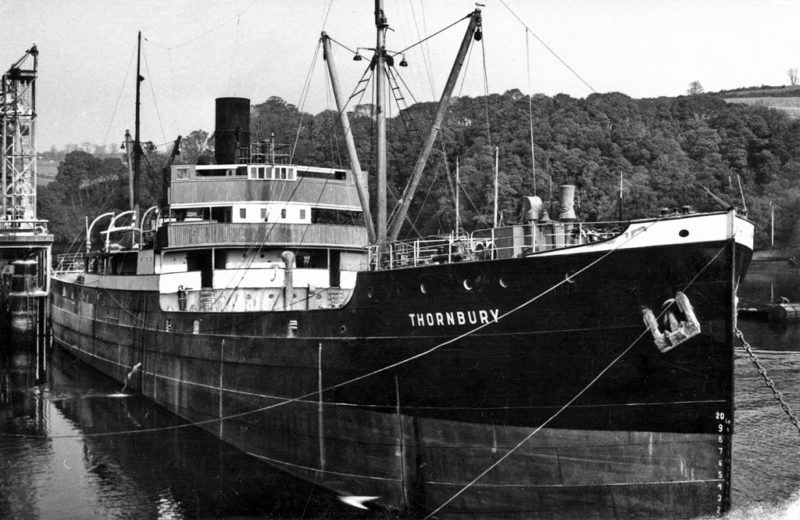
The Cardiff tramp Glocliffe became Tewkesbury in 1932.
The Liverpool tramp Wirral became Holmbury in 1934.
The Cardiff tramp Southborough became Shrewsbury in 1934.
The former Hopemount Shipping Co. Ltd., Newcastle Hopeland became Shaftesbury in 1935.
The Glasgow tramp Cairnhill became Ashbury in 1935, having been launched for Norwegian owners as Nitedal.
While the majority of the company tramps were engaged in trading to the River Plate with coal outwards and either grain or tinned meat and general homewards at the end of the Depression, the eldest tramp, Kingsbury of 1904, was trading with coal out to Genoa or Savona returning with iron ore from Bona or Oran to the Tyne or Clyde. She was sold to Evans & Reid in 1935 for the scrap part of their four-ship ‘Scrap & Build’ programme, and arrived at Troon for breaking up by West of Scotland Shipbreaking Co. Ltd. on 24th August 1936.
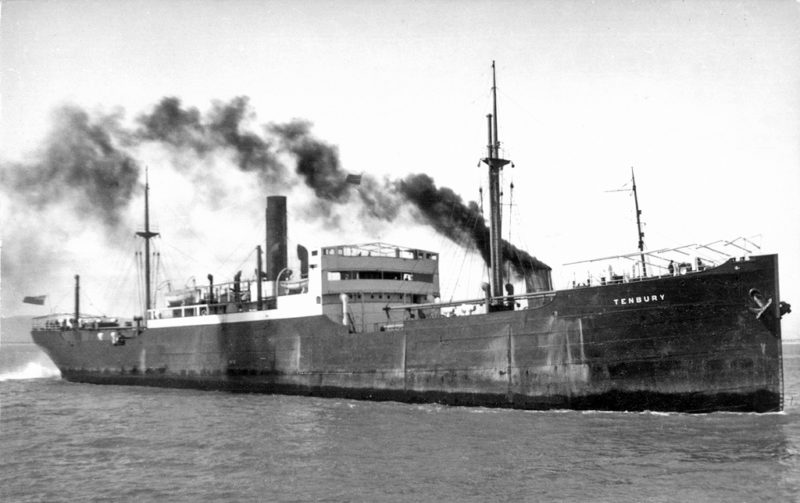
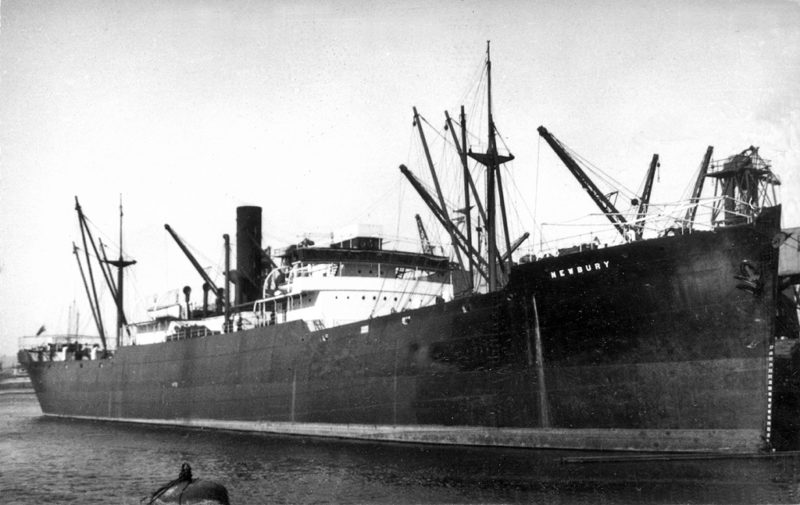
The much improved trading conditions of 1936/37 saw the dozen owned tramps all trading again, and they were joined by two new ‘Economy types’ from Burntisland SB Co. Ltd., Woodbury and Kingsbury at this time. Eastbury of 1905 was sold to C. Strubin & Company in 1937 reducing the fleet to 13 tramps and it remained at this size until the outbreak of WWII. The whole fleet was to be lost during the ensuing holocaust with Ashbury unfortunately lost due to a grounding in 1945:-
24.10.1939 Ledbury
Torpedoed/sunkby U-37 W of Straits of Gibraltar on a voyage from Toulon to Burntisland with bauxite.
9.7.1940 Aylesbury
Torpedoed/sunk by U-43 in Bay of Biscay on a voyage from Buenos Aires to Avonmouth with grain and general.
17.7.1940 Woodbury
Torpedoed/sunk by U-99 300 miles W of Land’s End on a voyage from General Uriburu and Halifax (NS) to Manchester with tinned meat, wheat and general.

2.9.1940 Bibury
Toorpedoed/sunk by U-46 in mid-Atlantic on a voyage from Cardiff to Buenos Aires with coal. All 39 crew were lost.
12.2.1941 Shrewsbury
Shelled/sunk by Admiral Hipper near Madeira on a voyage from Rosario and Freetown to U.K. with wheat and linseed, 20 lost.
12.2.1941 Westbury
Shelled/sunk by Admiral Hipper in same convoy on a voyage from Alexandria and Freetown to U.K. with cottonseed, cottoncake, onions and garlic, 5 lost.
21.5.1941 Tewkesbury
Torpedoed/sunk by U-69 in mid-Atlantic on a voyage from Rosario to Cape Verde Islands and Oban with grain, tinned meat and general.
6.6.1941 Queensbury
Bombed off Firth of Tay on a voyage from Buenos Aires to London with grain and general, 11 lost, ship sunk by escort.
15.9.1941 Newbury
Torpedoed/sunk by U-94 in mid-Atlantic on a voyage from Cardiff to Buenos Aires with coal, 45 lost.
28.5.1942 Charlbury
Sunk by torpedo and gunfire from Italian submarine Barbarigo to NE of Recife, Brazil on a voyage from Cardiff and Belfast Lough to Buenos Aires with coal, 2 lost.
12.7.1942 Shaftesbury
Torpedoed/sunk by U-116 in mid-Atlantic on a voyage from Newport to Buenos Aires with coal, Master taken prisoner of war.
17.3.1943 Kingsbury
Torpedoed/sunk by U-338 in mid-Atlantic on a voyage from Port Harcourt and New York to London with W. African produce and bauxite, 4 lost.
5.5.1943 Holmbury
Torpedoed/sunk by U-123 SE of Freetown on a voyage from Buenos Aires and Montevideo to Freetown and U.K. with general, 2 lost and Master taken prisoner of war.
8.1.1945 Ashbury
Wrecked in Kyle of Tongue, Northern Scotland on a voyage from Workington to the Tyne in ballast.
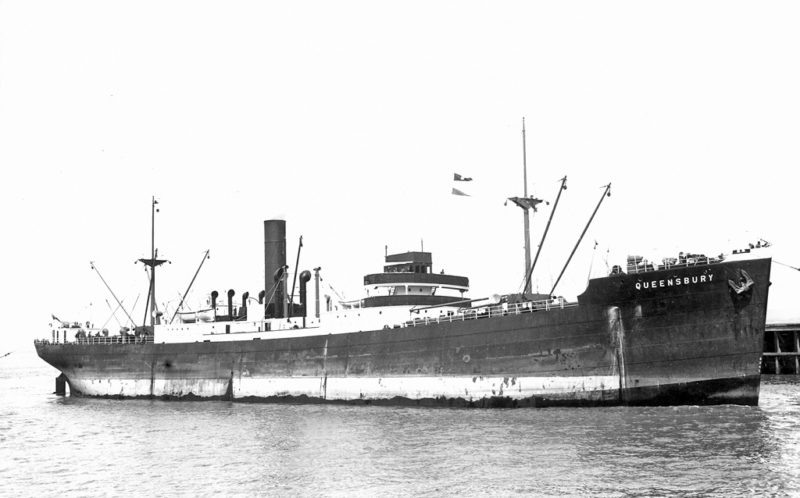
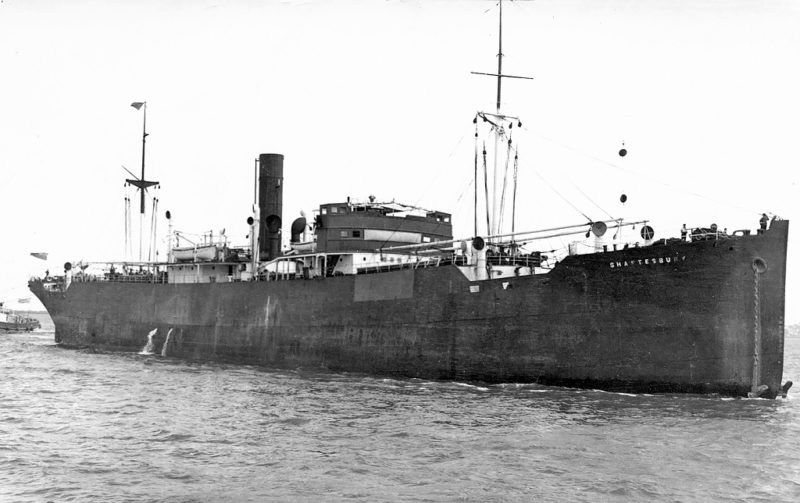
The first company loss ironically was the last of the former German prizes from the previous war, Ledbury. The new Charlbury, for which the company received a shipbuilding grant, was delivered in April 1940 and lost two years later. Two company ships were lost in the same seven-knot convoy SLS64 from Freetown to the heavy cruiser Admiral Hipper. Shrewsbury had sailed from Rosario and Westbury from Alexandria and they had been routed in the same convoy of ten ships homewards from Freetown. Unprotected without any escort the German heavy cruiser approached at speed from astern and was mistaken for a British battleship and took up station in the middle of the convoy. When the swastika was hoisted aloft her first salvo of shells sank the Commodore’s ship, Warlaby of Ropners. Shrewsbury under Capt. Armstrong suffered heavy casualties of twenty dead with eighteen killed by one shell as they attempted to pull away in a lifeboat. However her Master survived. Capt. Embleton was not so lucky as Westbury sank taking him and four of his crew to their deaths. Seven tramps were sunk by Admiral Hipper and the devastation was almost complete with Ropner’s Ainderby sunk by U-552 and Nailsea Lass sunk by U-48 as they neared home. The only survivor was Lornaston owned by William S. Miller of Glasgow which had been seriously damaged in the shelling and made for the Azores. After spending three months under repair in the neutral Azores, Lornaston limped into British coastal waters at the end of June 1941 six months after she had started her voyage.
Charles Alexander had died early in 1945, his brother Frank S. Alexander having been knighted in 1942 when Sheriff of London, and their other brother Waldemar J. Alexander were in poor health at the end of the war and retired in 1948. Ten ships had been managed for the Ministry of War Transport during the war including five ‘Empires’, four ‘Forts’ and the captured German prize Eilbek, completed in 1936. Empire Glen was the first of these to be purchased later in 1945 and renamed Aylesbury, followed by her sisters in 1946 renamed Charlbury, Bibury, Eastbury and Holmbury plus two ‘Liberties’ and one ‘Ocean’ in 1947/49 renamed Kingsbury, Ledbury and Malmesbury respectively.
In February, 1947 the purchase of a controlling interest and management of the Alexander Shipping Co. Ltd. was made by Houlder Brothers & Co. Ltd., a smaller shareholding having been taken in 1938 shortly after the company had been converted to public status in 1937.
Sir Frank Alexander joined the Board of Houlder Line Ltd. before retiring shortly after the takeover to allow his elder son Charles G. Alexander (later Sir Charles) to join the Board of Houlder Brothers & Co. Ltd. in May 1948. Charles G. Alexander was appointed to the Board of the Alexander Shipping Co. Ltd. in January 1949 on the resignation of Waldemar J. Alexander. Sir Frank later died at his home, Norsted Manor in Kent, on 18th July 1959. Charles G. Alexander rose to become Deputy Chairman of Houlder Brothers & Co. Ltd., and his brother John became manager of the Houlder Liverpool office in 1950 and joined the Houlder Board in 1960.
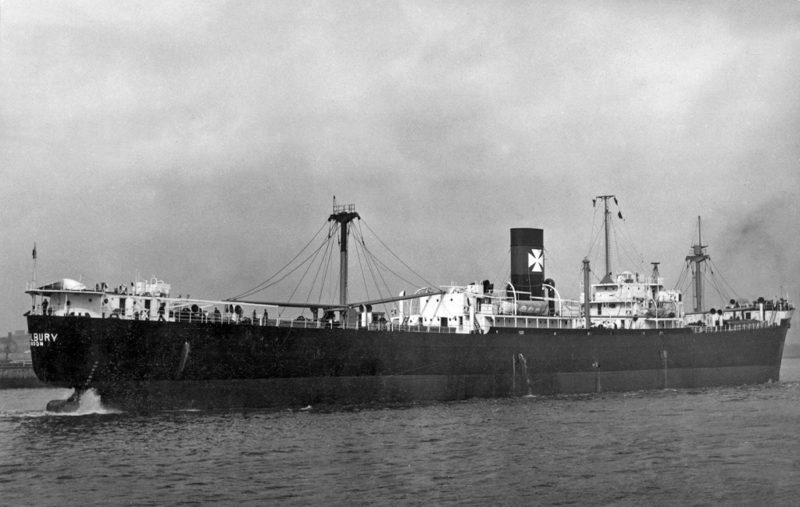
The new owners and managers used the eight standard war-built tramps on their traditional general cargo trade to the River Plate with coal and manufactured goods outwards, returning with grain or tinned meat. The crew living space of five of these tramps was later improved to single-berth cabins with movable furniture, and they were to stay in the Houlder fleet until around 1960.
The replacement programme for the Alexander Shipping Co. Ltd. general cargo traders consisted of five near-sisters, completed between June 1953 and October 1965:-
FIVE GENERAL CARGO SHIPS OF 12,500dwt
Burntisland SB Co. Ltd. (5) – Queensbury, Shaftesbury, Tewkesbury, Westbury, Tenbury.
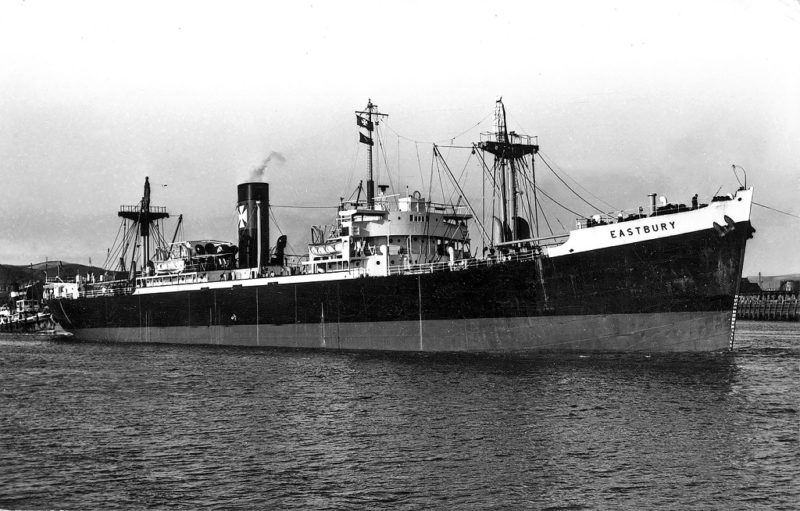
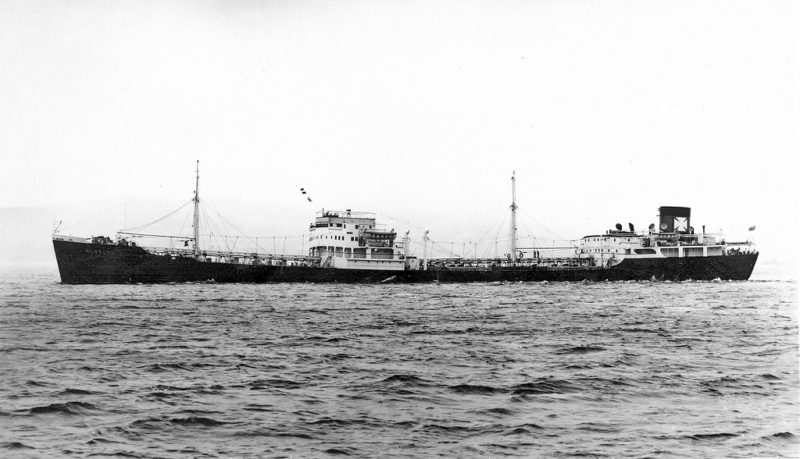
Another sister, Thorpe Grange, was completed by Bartram at Sunderland and registered under Houlder Line Ltd. All had five holds with three forward of the four-deck high superstructure and two aft, except in the case of Tenbury of 1965 which had four holds forward and one aft. A fine array of around 12 medium-to-heavy derricks were fitted and Tenbury also had prominent deckhouses. Queensbury on her regular run to the River Plate fouled her anchors with an Argentinean ship at Rosario in September 1962 leading to a slight collision and dents to her port bow. Engines varied with Shaftesbury, Tewkesbury, Westbury and Thorpe Grange having Doxford oil engines, Queensbury had twin Gray-Polar oil engines, while Tenbury had a Sulzer oil engine. They were sold out of the Group in the early 1970s with Westbury lasting the longest on the River Plate run before going to Greeks in 1978 as Diamando.
The only tanker to be registered under the company, the Clyde built Newbury of 1951, completed her 15 year charter to Shell in 1966 and was sold to Finnish owners. A new engines-aft general cargo ship of 15,600 dwt was launched as Banbury for the company at the Scotts yard at Greenock in 1971. She was fitted with eight raised deck cranes to enable deck timber and containers to be carried, and went into service on the Australian coast as Iron Banbury in 1972 having been chartered by the Broken Hill Proprietary Co. Ltd. At the end of this charter in 1975 she switched to the River Plate liner service as Banbury until she was sold in 1982.
The acquisition of the remaining Houlder shares not owned by Furness, Withy & Co. Ltd. was completed in December 1974 and brought new management onto the Houlder Board, with Sir Charles Alexander still active but playing a lesser role. His family had thus been shipowners for over a century from the setting-up of the original Capper, Alexander & Company in 1875 and although two tankers and two ‘B26’ bulkers were transferred to the Alexander Shipping Co. Ltd. by Furness, Withy & Co. Ltd. the Alexander family was not now at the helm. The ‘Bury’ fleet had thus made a notable contribution to British tramping history.
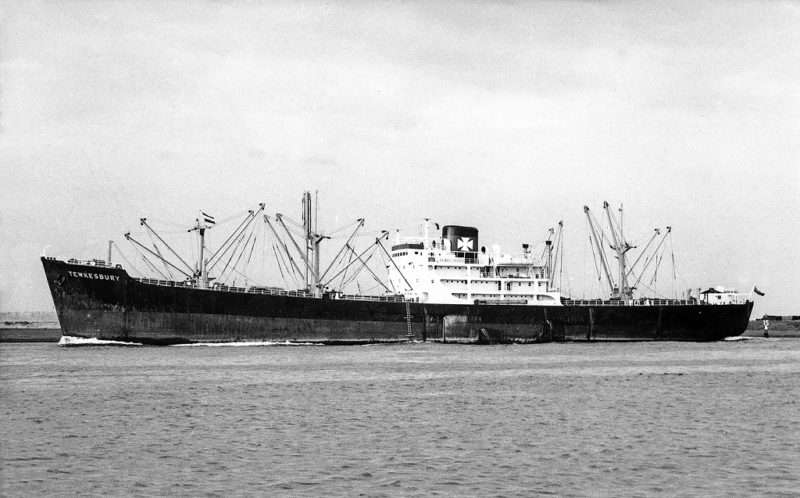
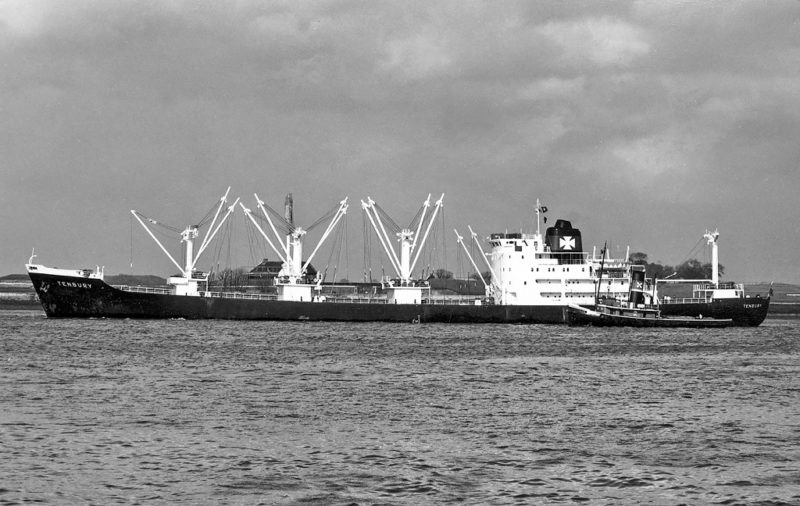

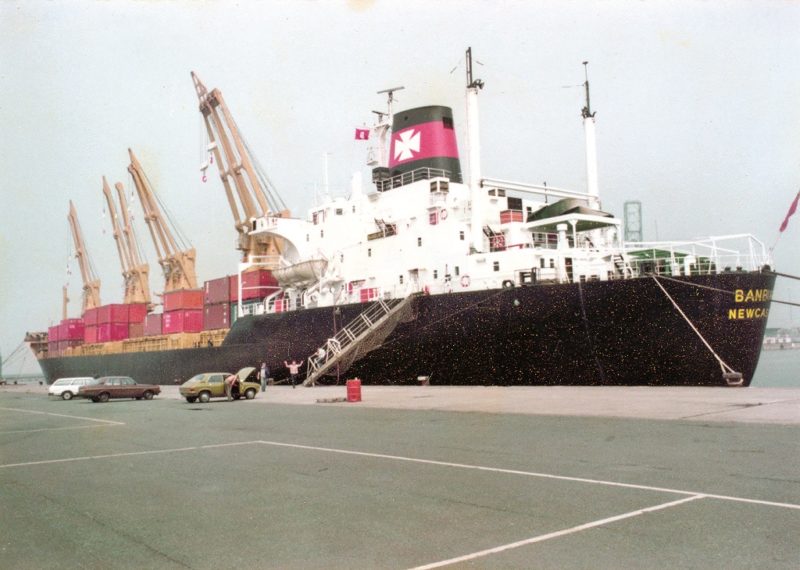
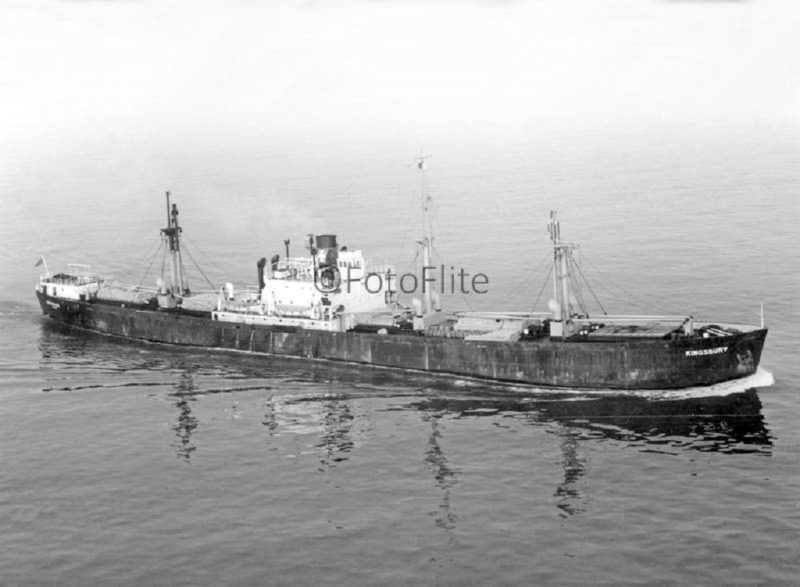
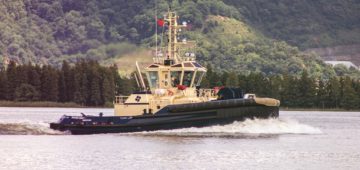



Comments
Sorry, comments are closed for this item